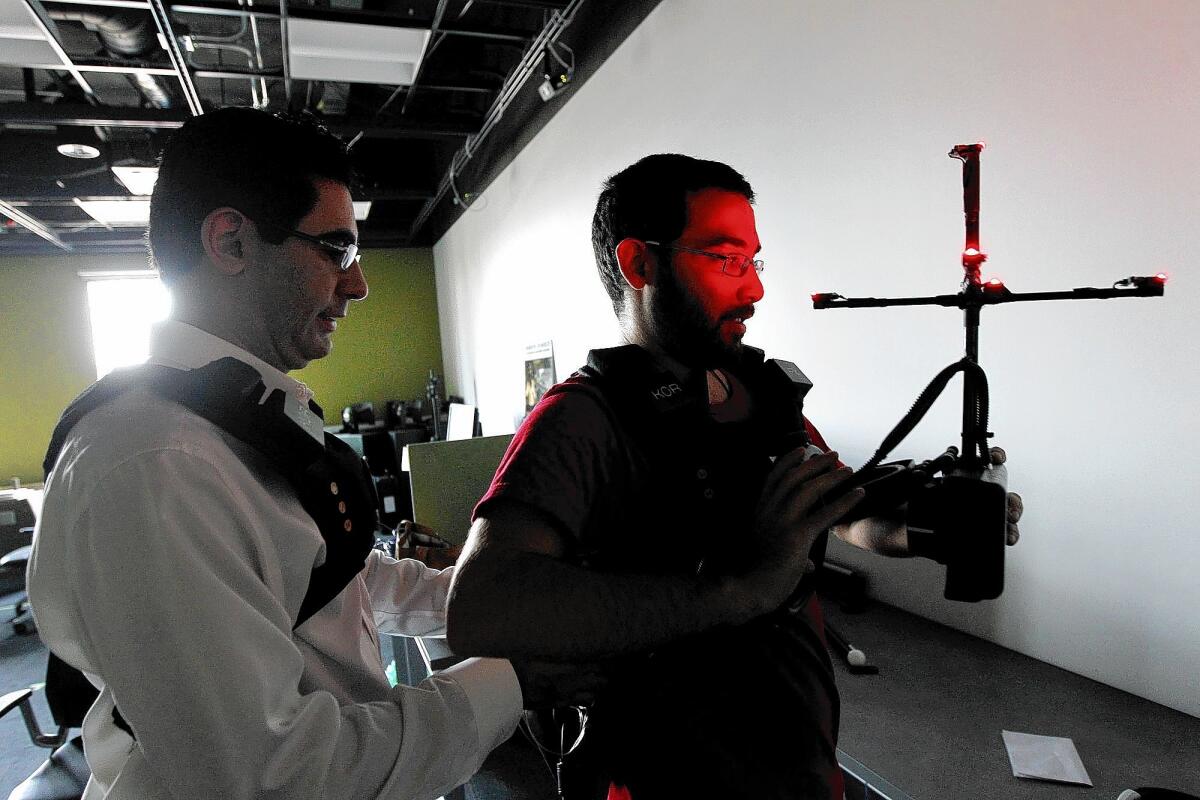Getting physical with virtual reality

- Share via
When Facebook acquired virtual reality headset developer Oculus VR for $2 billion in March, many in the tech industry lauded the move as heralding the next generation in computer gaming.
The potential of Oculus’ Rift goggles is tantalizing — rather than playing a game in front of a computer screen, gamers would get the visual sense they’re inside the game with a 360-degree view of the computer-generated action.
But for many technologists, the acquisition also marked a key turning point for virtual reality development. With renewed attention on virtual reality games, developers are now looking to expand the technology to even more immersive experiences that are not just visual but physical.
With new devices under development, users will be able to experience the thump of a virtual explosion, see their physical actions translated into virtual movements or remotely control heavy equipment with hand gestures.
USC researcher and virtual reality pioneer Mark Bolas said the new technologies are blurring the lines between reality and virtual and moving it outside the realm of gaming.
“Virtual reality can touch everything that reality touches,” Bolas said. “It’s stunningly difficult to limit the areas that I think it’s going to influence.”
Even though Irvine-based Oculus has yet to release a consumer model of its virtual reality headset, peripheral start-ups and entrepreneurs like Shahriar Afshar and others are looking to cash in on what they consider to be the next big medium in entertainment.
“I do feel like we’re at the foundations of something big,” said Afshar, whose Cambridge, Mass., company Immerz is developing a wearable chest piece that pairs well with virtual reality technology.
Afshar, a quantum physicist and former Harvard researcher, designed and invented the KOR-FX wearable chest piece, which sends vibrations of varying intensity to a user’s chest, based on what’s happening in the video.
The hardware isn’t just a “chest thumper,” Afshar said. He spent the last five years working on the haptic-audio technology behind KOR-FX, spending hundreds of thousands of dollars in development on different models before coming up with the current, lightweight version.
The Iranian-born Afshar said he first came up with the idea for the chest device while working at Rowan University as a visiting researcher. One summer, while staying in the dorms and writing academic papers, he was annoyed by the booming and vibrating sounds from teenagers playing video games in the dorm. Though annoyed, Afshar said he realized that the booming bass gave the gamers an extra level of enjoyment and immersion in the game.
The project has raised more than $148,000 on Kickstarter, and KOR-FX will begin shipping in September.
Though the KOR-FX works with most audio systems and isn’t limited to virtual reality systems, Afshar nonetheless found that the technology is more immersive in those environments.
At a meet-up at USC’s off-campus Mixed Reality lab in late June, Afshar met Michael Licht, a producer for immersive journalism project Virtual Pyedog.
Inside the lab building, where Oculus developer Palmer Luckey worked on the now-famous Rift headset, the Virtual Pyedog team was having attendees go through a simulation depicting a wartime explosion in the Syrian city of Aleppo.
The attendees, wearing specially designed virtual reality headsets, walked around the lab, their movements tracked by 18 video cameras mounted on the walls. Their actions were translated into virtual movements.
With the headsets, the attendees virtually ‘walk’ around a Syrian street corner, watching children play and cars whiz by until a rocket explosion plunges the area into smoke and panic.
The Virtual Pyedog team has developed three documentary-immersion simulations, including a border-crossing shooting and a diabetic man collapsing in in a food bank line. Licht said the studio is working on three more immersive journalism projects, including one designed around an upcoming Formula One race.
The founder of the virtual reality journalism project, former Newsweek writer Nonny de la Peña, said the next step is adding more feedback like the KOR-FX vest that improves the sense of immersion. Some users push the limits of the simulation and walk through characters or objects, ruining the immersive experience.
“It’s one of the things that we have to design for,” De la Peña said, adding that they are constantly striving to design more intuitive virtual reality worlds.
For De la Peña, who started Virtual Pyedog as part of her doctoral project at USC, the response has been overwhelming. The film school student, who just returned from a multi-week trip to Europe to demonstrate the Syria project, has had numerous conference invites and commissions for more immersive journalism projects.
“As far as I’m concerned, it’s like a dream come true,” she said.
More to Read
Inside the business of entertainment
The Wide Shot brings you news, analysis and insights on everything from streaming wars to production — and what it all means for the future.
You may occasionally receive promotional content from the Los Angeles Times.










